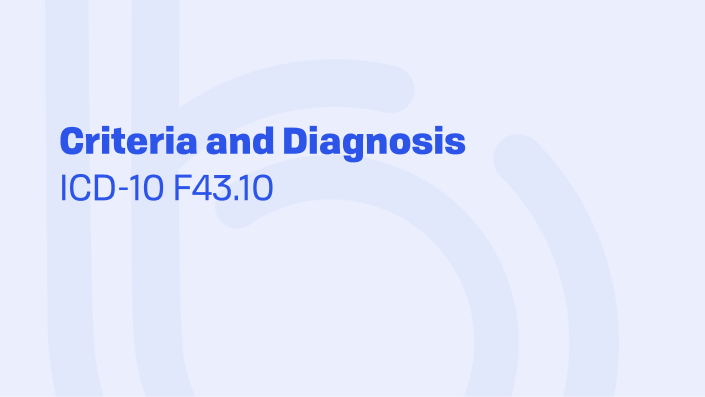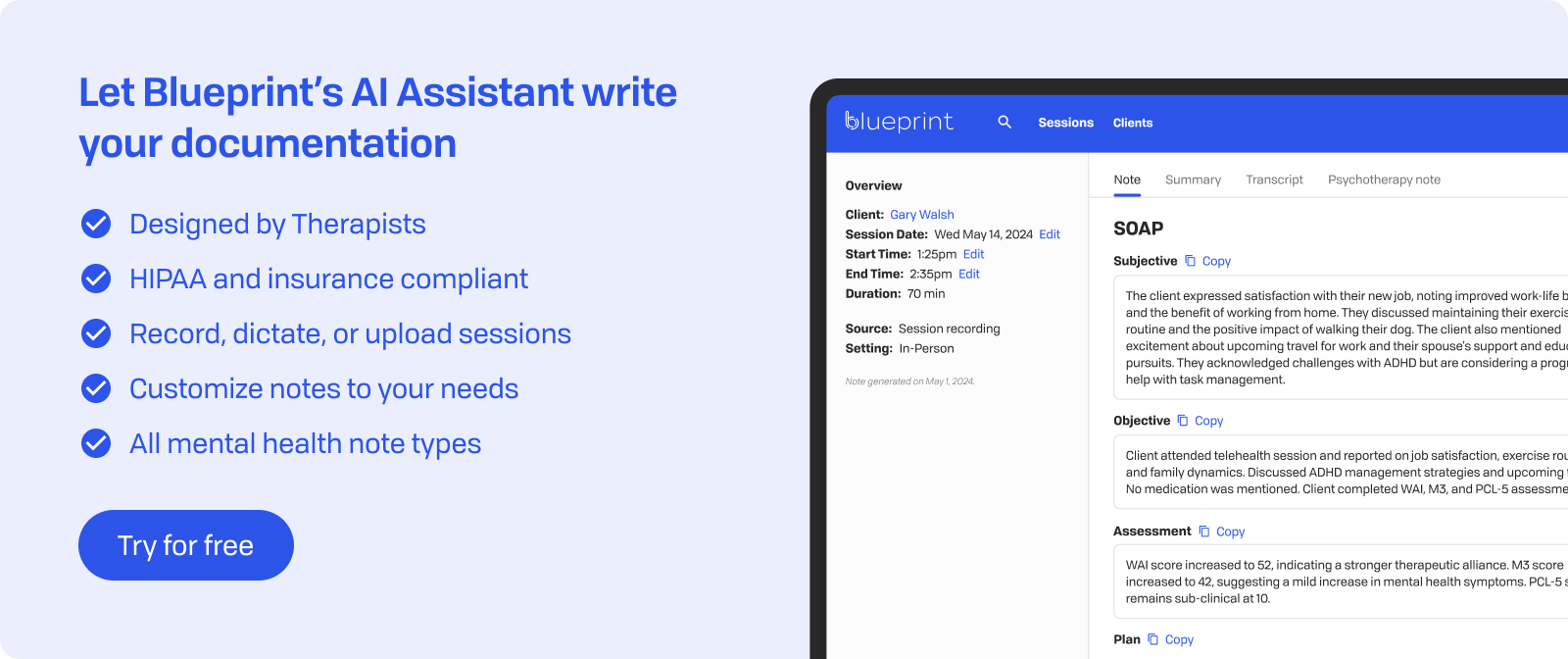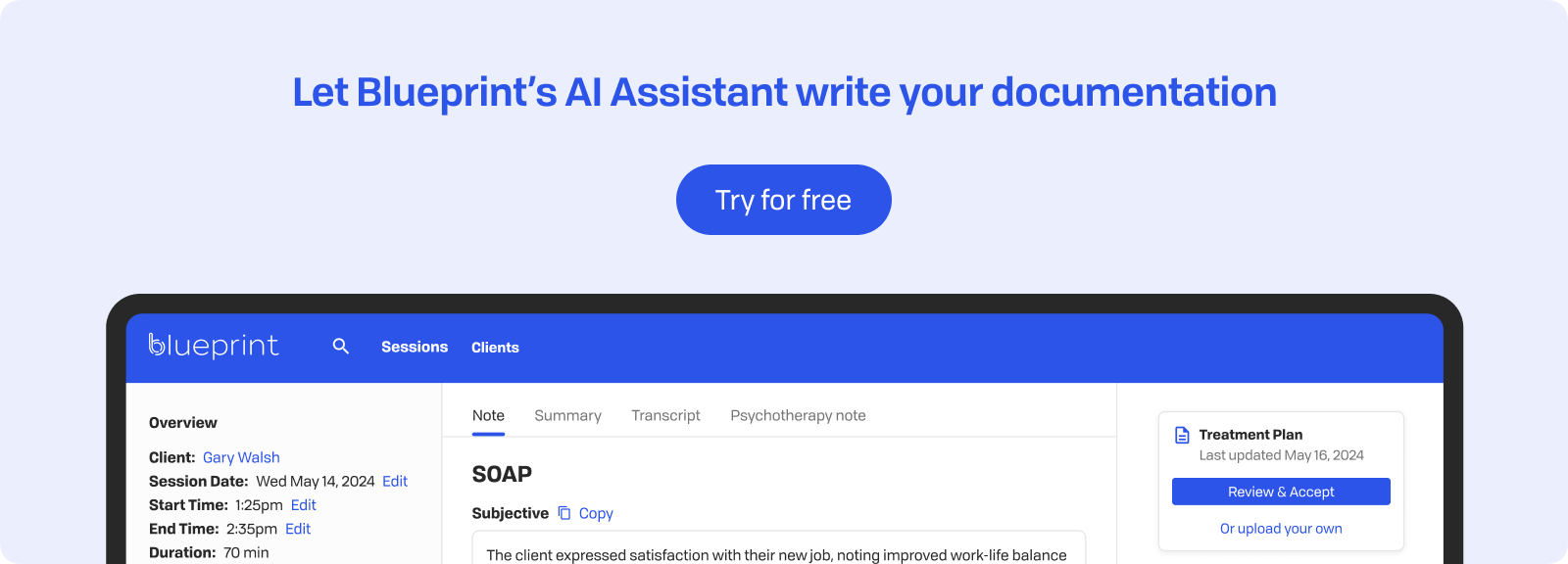
In Brief
When documenting a client's diagnosis, precision matters, but sometimes the clinical picture isn't crystal clear. You might find situations where trauma symptoms are evident, yet specific details about the intensity, onset, or duration of these symptoms remain unclear. In these cases, understanding the nuances of diagnostic coding for trauma-related disorders becomes important for accurate documentation and treatment planning.
The ICD-10 classification system provides specific codes for various presentations of post-traumatic stress disorder and other trauma-related disorders. Among these, F43.10, post-traumatic stress disorder, unspecified serves a unique purpose in clinical practice. This code bridges the gap between recognizing PTSD symptoms and achieving full diagnostic clarity.
F43.10 is the ICD-10-CM code for "Post-traumatic stress disorder, unspecified" and is located within the broader F43 category of reaction to severe stress and adjustment disorders. This code is useful when onset timing or symptom duration remains unclear during initial assessments. It ensures proper documentation for insurance billing while maintaining continuity of care across providers.

Diagnostic Criteria and When to Use F43.10
In the United States, clinicians typically diagnose post-traumatic stress disorder (PTSD) using criteria from the Diagnostic and Statistical Manual of Mental Disorders, Fifth Edition (DSM-5). The DSM-5-TR outlines specific symptom clusters for PTSD, including intrusive symptoms, avoidance, negative alterations in cognition and mood, and changes in arousal and reactivity—all of which must follow exposure to a qualifying traumatic event.
While the DSM-5-TR provides the diagnostic framework, clinicians are required to use ICD-10 codes for documentation and billing purposes. The ICD-10 code F43.10 – post-traumatic stress disorder, unspecified, is used when a client meets general criteria for PTSD, but the presentation lacks sufficient detail or specificity for a more precise code. This might occur early in treatment, during crisis stabilization, or when full diagnostic clarity is still being established.
Ambiguity in duration often leads to choosing F43.10 over more specific codes. While F43.11 indicates acute PTSD (symptoms lasting less than three months) and F43.12 denotes chronic PTSD (symptoms persisting beyond three months), real-world clinical scenarios don't always fit neatly into these timeframes. Clients may present with unclear symptom onset dates or inconsistent histories that make duration determination challenging.
Common scenarios where F43.10 may be appropriate include:
- The client clearly meets DSM-5 criteria for PTSD, but details about trauma history or symptom onset remain incomplete.
- Assessment is ongoing, but immediate documentation of PTSD is clinically warranted.
- The client exhibits PTSD symptoms, but does not neatly fit the duration or symptom severity criteria needed for a more specific ICD-10 code.
In these cases, F43.10 provides a flexible yet clinically valid way to document the presence of trauma-related symptoms while continuing to gather diagnostic information. Once more detail is available, the clinician may update the diagnosis to a more specific code that better reflects the client’s presentation.
Differentiating F43.10 from Other Codes
Knowing how F43.10 differs from related diagnostic codes ensures accurate documentation and appropriate treatment planning. The main differences focus on how long symptoms last and how they present clinically.
Duration-Based Distinctions:
- F43.11 (Acute PTSD): Symptoms appear for 1-3 months with a clear onset
- F43.12 (Chronic PTSD): Symptoms last longer than 3 months with documented duration
- F43.10 (Unspecified PTSD): Full PTSD criteria are met, but the duration is unclear or undocumented
The difference from F43.0 (Acute Stress Reaction) involves both timing and symptom profile. Acute stress reactions happen within days of trauma and resolve within one month, representing an immediate psychological response. These reactions often include prominent trauma symptoms and don't require the full PTSD symptom set. F43.10, on the other hand, requires meeting all PTSD diagnostic criteria as outlined in the DSM-5-TR regardless of timing clarity.
F43.2 (Adjustment Disorders) presents another important differentiation. Adjustment disorders involve emotional or behavioral symptoms in response to identifiable stressors but lack the specific trauma exposure and symptom clusters required for PTSD. The symptoms are less severe and don't include the characteristic trauma symptoms, such as re-experiencing, avoidance, and hyperarousal patterns.
Clinical and Billing Risks of Miscoding:
- Increased denial rates: Insurance companies may reject claims for insufficient documentation supporting specific duration codes
- Treatment mismatches: Using adjustment disorder codes for PTSD symptoms or an extended length of time beyond 6 months may signify an audit risk from the payor
- Audit vulnerabilities: Incorrect coding patterns can trigger compliance reviews and possible recoupment actions
Proper code selection directly affects treatment authorization, session frequency approval, and continuity of care across providers.

Documentation Best Practices for F43.10
Thorough symptom documentation is important even when specific onset or duration details are unavailable. The absence of a clear timeline doesn't diminish the need to capture the full clinical picture. Your documentation should show that PTSD criteria are met while explaining why the unspecified code is most appropriate.
Key Elements to Record:
- Trauma History: Document the traumatic event(s) with enough detail to establish Criterion A, including the client's role (direct experience, witnessing, learning about, or repeated exposure).
- Symptom Clusters: Record specific examples from each required domain:
- Re-experiencing: nightmares, flashbacks, intrusive thoughts, emotional/physical reactions to reminders.
- Avoidance: efforts to avoid trauma-related thoughts, feelings, or external reminders.
- Negative alterations: persistent negative beliefs, distorted blame, detachment, inability to experience positive emotions.
- Arousal/reactivity: hypervigilance, exaggerated startle, sleep disturbance, concentration problems.
- Functional Impairment: Detail how symptoms affect work, relationships, daily activities, and overall functioning.
Explaining the Unspecified Designation:
Your progress notes should clearly state why F43.10 is appropriate. Include phrases like "Client unable to specify symptom onset date" or "Duration of symptoms unclear due to multiple trauma exposures." Document attempts to clarify the timeline and plans to reassess duration in future sessions.
Consider using standardized measures like the PCL-5 to support your clinical observations and diagnosis decision-making. These tools provide objective data that strengthens documentation while tracking symptom severity over time.
Implications for Treatment Planning and Clinical Strategy
Using F43.10 doesn't restrict your treatment options. Evidence-based trauma-focused therapies remain appropriate and effective whether you can specify acute or chronic presentation. The key is adjusting your approach to manage the diagnostic uncertainty while keeping the therapeutic process moving forward.
Recommended Interventions Include:
- Trauma-Focused CBT: Addresses cognitive distortions and maladaptive behaviors without needing precise timeline knowledge
- EMDR: Processes traumatic memories effectively whether symptoms are recent or have been present for a long time
- CPT or PE: Both protocols work well with unclear onset, focusing on reducing symptoms rather than duration
- Stabilization techniques: Especially useful when gathering more historical information during early sessions
Your treatment plan should include regular reassessment points to clarify the diagnostic picture. Schedule formal reviews at 4-week intervals to evaluate whether enough information has emerged to specify F43.11 or F43.12. Document these reassessment plans in your initial notes to show clinical thoroughness.
Monitoring Strategies:
- Track symptom severity using standardized measures (PCL-5)
- Note any emerging timeline details during therapy
- Document functional improvements regardless of duration clarity
- Set specific dates for diagnostic code review
Coordinating care becomes particularly important when using provisional coding. Clear communication with psychiatrists, primary care providers, and other team members ensures everyone understands the diagnostic ambiguity. Include explicit notes about the unspecified designation in referral letters and treatment summaries. This transparency prevents confusion and maintains a clear treatment focus across all providers involved in the client's care.

Billing, Compliance, and Practice Management Considerations
F43.10 is a billable ICD-10-CM code that allows for appropriate reimbursement when PTSD criteria are met but the specific duration remains unclear. Knowing the billing details of this code helps prevent claim denials and ensures smooth practice operations.
Common Documentation Pitfalls:
- Using F43.1 alone: This general code lacks the specificity required for proper billing and will likely result in claim rejections.
- Insufficient session detail: Failing to document session length, interventions used, and clinical rationale for the unspecified designation.
- Missing symptom documentation: Not recording specific examples from each PTSD symptom cluster leaves claims vulnerable to denial.
- Unclear justification: Omitting an explanation for why the duration cannot be specified at the time of diagnosis.
The interaction between F43.10 and CPT codes requires careful attention. Your psychotherapy duration codes (90834, 90837, etc.) must align with documented session times and clinical necessity. Many payers have specific requirements for trauma-focused therapy authorization that depend on accurate ICD-10 coding from the start.
Electronic health record systems should include prompts to capture duration attempts and rationale for unspecified coding.
Regular staff training on these updates ensures consistent coding practices across your practice. Consider implementing documentation templates that specifically address the elements needed to support F43.10 usage while planning for a transition to more specific codes as clinical information becomes available.
Clinical Scenarios and Case Examples
Let's look at how F43.10 applies in specific clinical situations.
Case 1: Unclear Symptom Onset
A 35-year-old experiences nightmares, hypervigilance, and avoidance behaviors after a car accident. She reports having a history of trauma, including sexual and physical abuse, from childhood which she has never received treatment for. She mentions that her current symptoms of irritability, nightmares, avoidance, and jumpiness started "sometime after" the accident. She also stated she has always had some jumpiness and nightmares but recently they have gotten much worse. She is not able to describe the intensity or onset of her symptoms prior to the car accident. You document:
- Full PTSD criteria met
- Trauma exposure confirmed (motor vehicle accident, abuse as a child)
- Precise symptom onset not established
- Code: F43.10 with a plan to clarify the timeline over the next 2-3 sessions
Case 2: Emergency Department Assessment
A veteran arrives at the ED with severe flashbacks, passive suicidality, and panic symptoms. Limited time and acute presentation prevent comprehensive history-taking. The hospital social worker uses F43.10 as one of the diagnostic codes while coordinating referrals for an intensive outpatient program. Transition Guidelines for Code Updates:
- IOP therapist task: Review initial assessment notes and obtain additional information
- Documentation needed: Specific symptom onset date or clear duration markers
- To diagnose with F43.11: Confirm symptoms began within the past 3 months
- To diagnose F43.12: Establish symptoms have persisted beyond 3 months
- Update requirements: Amend diagnosis in treatment plan, update billing paperwork, and a write a clear progress note explaining the change in diagnosis
These transitions typically happen as therapeutic rapport develops and clients feel more comfortable sharing detailed histories.

Key Takeaways
F43.10 acts as an important diagnostic tool when PTSD symptoms are apparent but details about timing are unclear. Use this code when clients meet all core PTSD criteria but can't provide specific information about when symptoms started or how long they've lasted. This ensures clients have access to appropriate treatment while keeping the diagnosis accurate.
Important Documentation Checklist:
- Confirm Criterion A: Record trauma exposure through direct experience, witnessing, learning about, or repeated exposure
- Verify symptom clusters: Include specific examples of re-experiencing, avoidance, negative changes, and arousal symptoms
- Note duration uncertainty: Clearly explain why the onset/duration cannot be determined
- Document functional impact: Describe how symptoms affect work, relationships, and daily activities
- Plan reassessment: Schedule specific dates to review and possibly update the diagnosis
Accurate coding significantly affects both clinical care and the sustainability of practice. Proper use of F43.10 prevents claim denials while ensuring clients receive trauma-focused interventions without delay. Your documentation should clearly explain the unspecified designation, showing your attempts to establish duration, though currently undetermined.
The adaptability of F43.10 allows immediate initiation of evidence-based PTSD treatment rather than waiting for complete historical clarity. This code acknowledges that trauma survivors often have memory gaps or confusion about timelines. As therapeutic rapport grows and more information becomes available, you can transition to F43.11 or F43.12 when suitable, maintaining continuity of care throughout the diagnostic process.

How Blueprint can help streamline your workflow
Blueprint is a HIPAA-compliant AI Assistant built with therapists, for the way therapists work. Trusted by over 50,000 clinicians, Blueprint automates progress notes, drafts smart treatment plans, and surfaces actionable insights before, during, and after every client session. That means saving about 5-10 hours each week — so you have more time to focus on what matters most to you.
Try your first five sessions of Blueprint for free. No credit card required, with a 60-day money-back guarantee.























